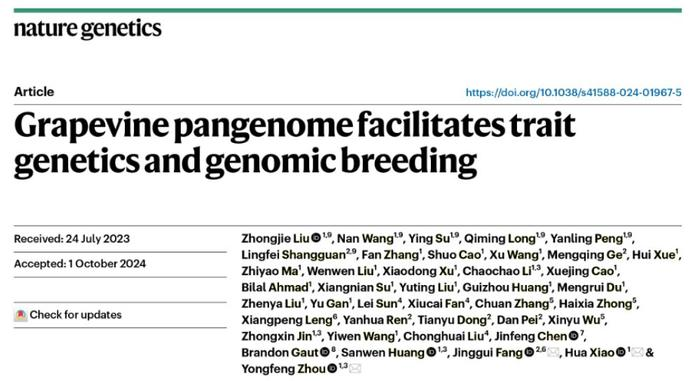From the Chinese Academy of Agricultural Sciences Institute of Genomics official WeChat public number was informed that today "Nature Genetics" published online the Chinese Academy of Agricultural Sciences, Shenzhen Institute of Agricultural Genomics (Lingnan Modern Agricultural Science and Technology Laboratory of Guangdong Province, Shenzhen sub-center) Zhou Yongfeng team using theAIcarry outgrape breedingThe latest research results of theThis study will dramatically shorten the grape breeding cycle and predict grape agronomic traits with an accuracy of up to 85%.Breeding efficiency can be increased by 400% compared to traditional methods.. This research is expected to realize precision design breeding for grapes, accelerate grape variety innovation, and provide methodological references for breeding other perennial crops.

Yongfeng Zhou's team has been focusing on design breeding in grapes since 2015, and released the first complete reference genome atlas of grapes from telomere to telomere in 2023, which was published as a cover article in Horticulture Research (Horticulture Research).
However, to realize precise "design", a genome data is far from enough. On this basis, Zhou Yongfeng's team sequenced and assembled 9 diploid grape varieties, including wild species and cultivars, and obtained 18 telomere-to-telomere haplotype genomes, as well as integrating the existing genomic data, constructing the first and most comprehensive and accurate grapevine pan-genome (Grapepan v1.0), with a total length of 1.43 Gb, nearly three times the size of a single reference genome. The total length of Grapepan v1.0 is 1.43Gb, which is nearly three times the size of a single reference genome.
In order to further clarify the association between grape genes and traits, Zhou Yongfeng's team selected more than 400 representative grape varieties from nearly 10,000 grape varieties, and investigated 29 agronomic traits including cluster size, metabolite content in berries, berry size and skin color for three consecutive years, and constructed a grape genotype atlas and trait atlas. On this basis, Zhou Yongfeng's team utilized quantitative genetic analysis to identify 148 loci significantly related to agronomic traits, of which 122 loci were found for the first time. It was found that there were correlations between loci regulating different traits, such as the proximity of loci related to soluble solids content and berry width. In addition, there were regions of significant differentiation between different grape populations (wine, table, and American table hybrids), and these regions contained genetic loci associated with a number of traits such as berry color, skin astringency, berry shape, cluster weight, pulp hardness, and fruit size, suggesting that divergent selection on agronomic traits promotes the differentiation between wine and table grapes.
Comprehensive and accurate genomic data is the basis for accurate breeding "design", but how to mine these data to optimize breeding strategies and guide breeding? This is the question that intelligent breeding must answer.Zhou Yongfeng's team decided to introduce machine learning to guide and optimize the breeding strategy by constructing a prediction model to predict and select early individuals based on scores.
In this study, the researchers divided the data containing traits and genotypes into three subsets: training set, validation set and test set. Machine learning algorithms were used to parse the complex network relationship between genotype and trait data, the training data set was used to construct the first grape genome-wide selection model, the study further adjusted the model parameters and optimized the model through the validation set, and finally the test data set was used to evaluate the performance of the final model. The results of the study showed thatCombining structural variant information and machine learning models for computational polygenic scoring predicts accuracy up to 85%.
With this model, breeders can quickly and accurately assess the genetic potential of a large amount of breeding material, leading to better selection of superior varieties. In contrast to crossbreeding, which requires judgments based on the phenotype of grapes after ripening, theGenome-wide selection breeding technology predicts grapevine traits at maturity at the seedling stage, eliminating unqualified seedlings as early as possibleIt reduces unnecessary labor costs and inputs, and has great potential for application in grape breeding applications to improve the efficiency of grape breeding, accelerate the creation of new grape germplasm, and revolutionize grape breeding strategies.
At present, six national invention patents have been applied for and approved, and one international patent has been applied for.